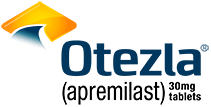First and only oral therapy approved for mild, moderate, and severe plaque psoriasis, and active PsA SEE THE DATA

*Doses of Otezla were titrated during the first week of administration and at week 16 when placebo patients were switched to Otezla. †A responder was defined as a patient achieving ≥PASI-75; a partial responder was defined as a patient achieving PASI-50 to PASI-74; a nonresponder was defined as a patient achieving <PASI-50 in both ESTEEM 1 and ESTEEM 2 at week 32. ‡At week 32, nonresponders and partial responders (ESTEEM 1) or nonresponders only (ESTEEM 2) had the option of adding topical and/or UVB therapy. The decision could be made at week 32 and was based on the discretion of the investigator.
- Evaluated in 2 multicenter, double-blind, placebo-controlled trials of similar design. Patients with moderate to severe plaque psoriasis (N=1257) were randomized 2:1 to Otezla 30 mg BID or placebo for 16 weeks after a 5-day titration 1
-
At week 16, all patients originally assigned to placebo transitioned to Otezla 30 mg BID. At week 32, some patients originally randomized to Otezla were, based on clinical response, re-randomized to Otezla or placebo. Those re-randomized to placebo restarted Otezla 30 mg BID at loss of response, but no later than at week 52 2,3
- In ESTEEM 1, patients were switched to Otezla if they lost their PASI-75 but no later than week 52
- In ESTEEM 2, patients were switched to Otezla if they lost 50% of the PASI improvement obtained at week 32 compared to baseline but no later than week 52
- Patients entering a long-term extension phase could be treated through 5 years 2,3





